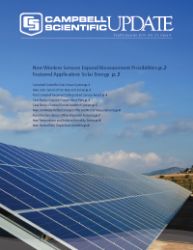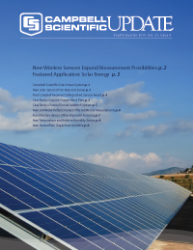
It is particularly satisfying for us at Campbell Scientific when we develop technologies or products that benefit a large number of our customers. Because of this, we are excited to release our new wireless-sensor product line that allows sensors to be installed at a distance from the datalogger without connecting cables.
Freeing sensors from the location of the datalogger significantly expands the measurement possibilities in many applications, while at the same time simplifying installation and reducing costs. Networks of rain gauges can be scattered through a watershed as needed. Large numbers of strain gauges can more easily be interspersed on a structure. You can probably think of other scenarios where it would be useful to place a sensor several hundred meters away from the datalogger.
The new family of wireless products consists of the CWB100 base station, the CWS220 infrared radiometer, the CWS655 soil-water-content sensor, and the CWS900 configurable interface—a component that adds wireless functionality to a wide variety of sensors.

The most significant benefits of the new product line are the wireless communication, small size of the components, the low cost, and the simplicity of setup. Wireless communication allows for placement of sensors without the worry, effort, and expense of laying cable to each measurement point. In many measurement setups, cables present a difficulty and can be expensive and labor-intensive to install. Once installed, users may be inhibited from changing their configuration because of the time and effort already invested. Also, cables are susceptible to damage from machinery, weather, and pests. Wireless sensors eliminate these problems.
Power concerns have been minimized by a low-power design that requires only two AA batteries (they can last a year with 15-minute sensor polls), and by a solar-power option that can stay charged with just three hours of light per day.
Another benefit is that the wireless sensors can be easily configured without complex programming and they can be integrated into full datalogger systems. The base station resides at the datalogger and polls the sensors via radio. Data can be relayed through a mesh network that uses as many as three hops—from one wireless sensor in the network to another. The base station stores the data until the datalogger requests it. While the path to the datalogger is wireless, the sensor data is the same as if each sensor was directly connected to the datalogger.
Here at Campbell Scientific, we are excited about the potential that these new wireless products hold. They are compact, use little power, and are rugged and weather-sealed. The sensor modules are each leak tested before shipping, and in real-world testing they have withstood rain, snow, wind, and hail. Even when installed 3 ft below the canopy in a mature corn field, they were able to transmit up to 500 ft. The possibilities are very encouraging. Contact Campbell Scientific to see if these wireless networks can work for you.
Here are descriptions of each member of this new family of wireless sensors.
CWB100 Wireless Base Station
The base station is the master radio in the wireless network. It polls the wireless sensors (it can store data from up to 50 sensors) and passes the data to the datalogger when requested. It can connect to a PC for configuration, and communicates with the datalogger via serial protocol using a single control port. The base station uses a frequency-hopping, spread-spectrum radio in the 900-MHz range(also available in other ranges). These features give it longer range and less interference, so the radio can communicate with sensors over 1,000 ft away in optimal line-of-sight conditions. Data can be relayed up to three hops in a mesh network, since every wireless sensor can act as a relay node for other wireless sensors in the network.
CWS220 Wireless Infrared Radiometer
The CWS220 integrates Apogee’s SI-111 infrared sensor with a radio in one compact body. It is used to sense infrared radiation from surfaces to calculate the surface temperature without physical contact.
CWS655 Wireless Soil-Water Sensor
This sensor has rods that insert into the ground to measure soil-water content, electrical conductivity (EC), and soil temperature. CWS655 wireless sensors can be spread out over a field and transmit the data to a base station in a secure location away from the field.
CWS900 Wireless Sensor Interface
The CWS900 is particularly exciting to introduce because of the broad spectrum of measurements it can bring into these wireless networks. It is a radio with a sealed connector that can be attached to a variety of sensors. It can measure analog voltage and frequency, count pulses, and supply excitation voltage, making it compatible with many types of low-power sensors. The connector to attach the sensor to the wireless interface is a conventional type that can be specified when ordering sensors from Campbell Scientific. We will also offer a terminal interface that will allow one of your existing sensors with a pigtailed cable to attach to the connector on the CWS900.

